An Analysis of Digital Payment Impact on Commercial Bank Performance
VerifiedAdded on 2023/01/07
|28
|6563
|26
Report
AI Summary
This report delves into the effects of digital payments on commercial bank performance, examining the development of digital payment systems and their relationship with third-party payment providers. It explores the positive and negative influences, including cooperation, competition, and coopetition, within the financial sector. The report reviews prior studies, identifies research gaps, and outlines theoretical foundations such as financial intermediary and technology spillover theories. It analyzes the impact of digital payments on bank efficiency, profitability, and strategic decision-making, providing a comprehensive overview of the evolving financial landscape and its implications for commercial banks. The study also highlights the innovations in the digital payment landscape and its impact on the banking sector.

Acknowledgments
Paraphrase This Document
Need a fresh take? Get an instant paraphrase of this document with our AI Paraphraser

Abstract
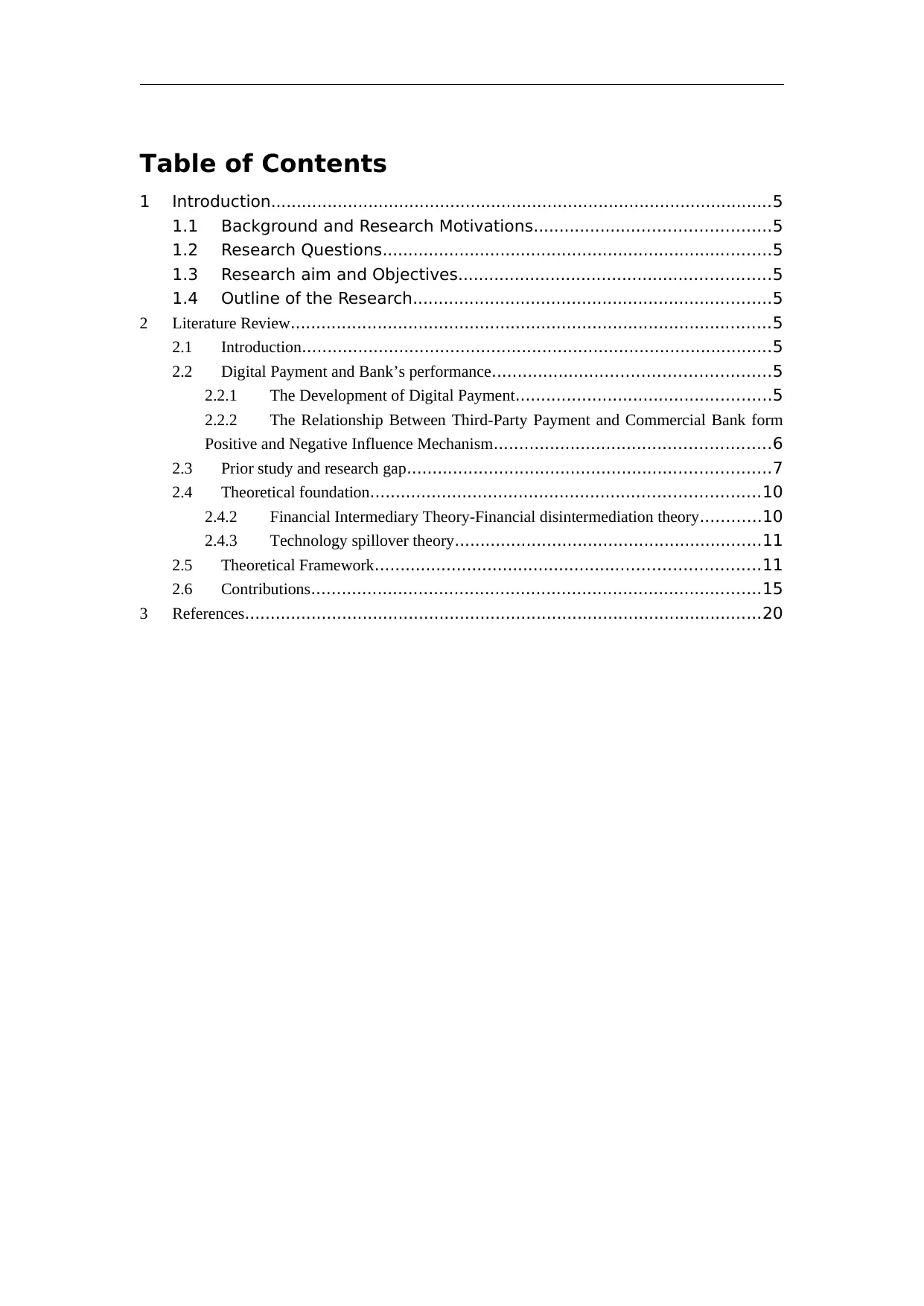
Table of Contents
1 Introduction..................................................................................................5
1.1 Background and Research Motivations..............................................5
1.2 Research Questions............................................................................5
1.3 Research aim and Objectives.............................................................5
1.4 Outline of the Research......................................................................5
2 Literature Review..............................................................................................5
2.1 Introduction............................................................................................5
2.2 Digital Payment and Bank’s performance......................................................5
2.2.1 The Development of Digital Payment..................................................5
2.2.2 The Relationship Between Third-Party Payment and Commercial Bank form
Positive and Negative Influence Mechanism......................................................6
2.3 Prior study and research gap.......................................................................7
2.4 Theoretical foundation............................................................................10
2.4.2 Financial Intermediary Theory-Financial disintermediation theory............10
2.4.3 Technology spillover theory............................................................11
2.5 Theoretical Framework...........................................................................11
2.6 Contributions........................................................................................15
3 References.....................................................................................................20
1 Introduction..................................................................................................5
1.1 Background and Research Motivations..............................................5
1.2 Research Questions............................................................................5
1.3 Research aim and Objectives.............................................................5
1.4 Outline of the Research......................................................................5
2 Literature Review..............................................................................................5
2.1 Introduction............................................................................................5
2.2 Digital Payment and Bank’s performance......................................................5
2.2.1 The Development of Digital Payment..................................................5
2.2.2 The Relationship Between Third-Party Payment and Commercial Bank form
Positive and Negative Influence Mechanism......................................................6
2.3 Prior study and research gap.......................................................................7
2.4 Theoretical foundation............................................................................10
2.4.2 Financial Intermediary Theory-Financial disintermediation theory............10
2.4.3 Technology spillover theory............................................................11
2.5 Theoretical Framework...........................................................................11
2.6 Contributions........................................................................................15
3 References.....................................................................................................20
⊘ This is a preview!⊘
Do you want full access?
Subscribe today to unlock all pages.

Trusted by 1+ million students worldwide
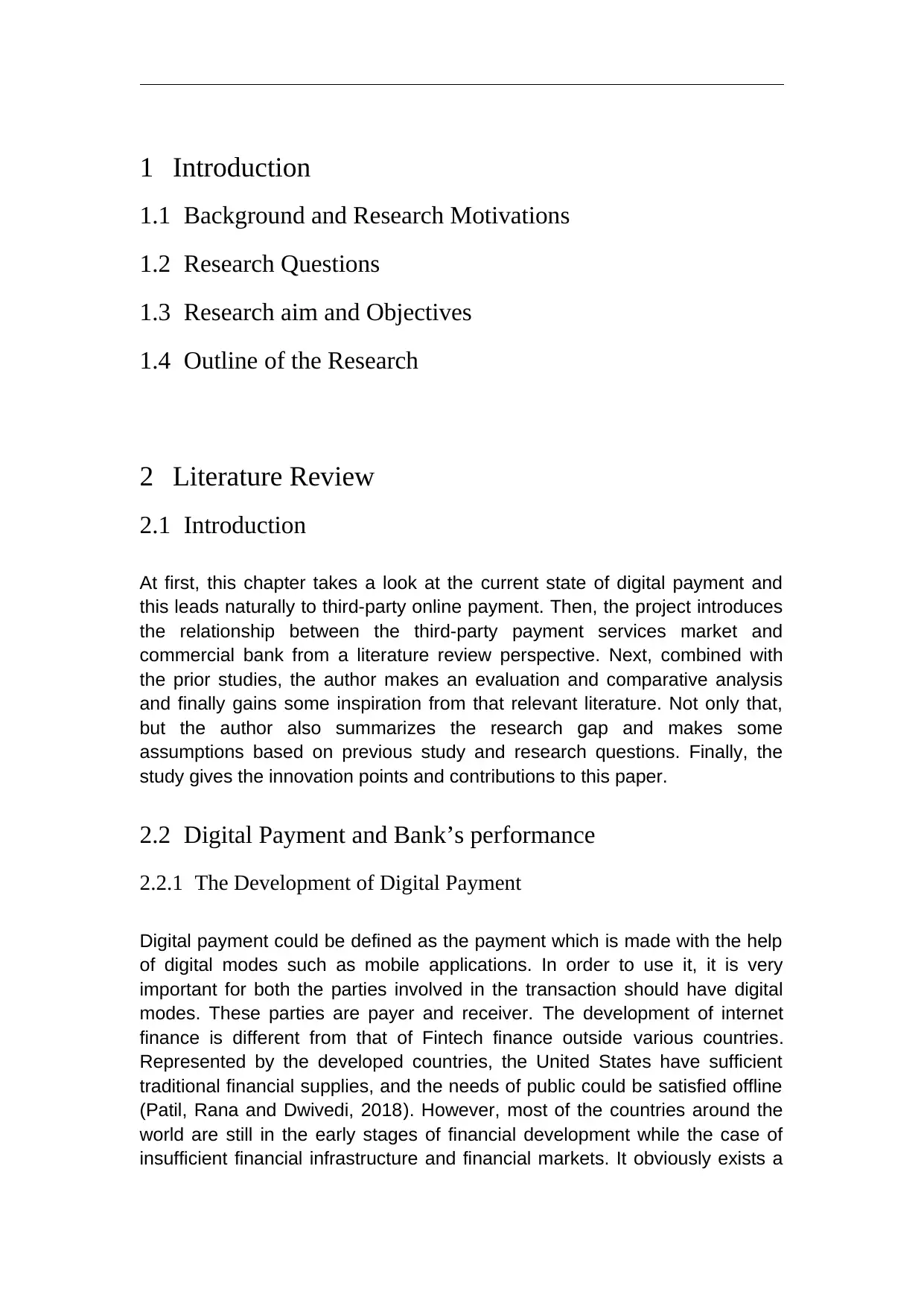
1 Introduction
1.1 Background and Research Motivations
1.2 Research Questions
1.3 Research aim and Objectives
1.4 Outline of the Research
2 Literature Review
2.1 Introduction
At first, this chapter takes a look at the current state of digital payment and
this leads naturally to third-party online payment. Then, the project introduces
the relationship between the third-party payment services market and
commercial bank from a literature review perspective. Next, combined with
the prior studies, the author makes an evaluation and comparative analysis
and finally gains some inspiration from that relevant literature. Not only that,
but the author also summarizes the research gap and makes some
assumptions based on previous study and research questions. Finally, the
study gives the innovation points and contributions to this paper.
2.2 Digital Payment and Bank’s performance
2.2.1 The Development of Digital Payment
Digital payment could be defined as the payment which is made with the help
of digital modes such as mobile applications. In order to use it, it is very
important for both the parties involved in the transaction should have digital
modes. These parties are payer and receiver. The development of internet
finance is different from that of Fintech finance outside various countries.
Represented by the developed countries, the United States have sufficient
traditional financial supplies, and the needs of public could be satisfied offline
(Patil, Rana and Dwivedi, 2018). However, most of the countries around the
world are still in the early stages of financial development while the case of
insufficient financial infrastructure and financial markets. It obviously exists a
1.1 Background and Research Motivations
1.2 Research Questions
1.3 Research aim and Objectives
1.4 Outline of the Research
2 Literature Review
2.1 Introduction
At first, this chapter takes a look at the current state of digital payment and
this leads naturally to third-party online payment. Then, the project introduces
the relationship between the third-party payment services market and
commercial bank from a literature review perspective. Next, combined with
the prior studies, the author makes an evaluation and comparative analysis
and finally gains some inspiration from that relevant literature. Not only that,
but the author also summarizes the research gap and makes some
assumptions based on previous study and research questions. Finally, the
study gives the innovation points and contributions to this paper.
2.2 Digital Payment and Bank’s performance
2.2.1 The Development of Digital Payment
Digital payment could be defined as the payment which is made with the help
of digital modes such as mobile applications. In order to use it, it is very
important for both the parties involved in the transaction should have digital
modes. These parties are payer and receiver. The development of internet
finance is different from that of Fintech finance outside various countries.
Represented by the developed countries, the United States have sufficient
traditional financial supplies, and the needs of public could be satisfied offline
(Patil, Rana and Dwivedi, 2018). However, most of the countries around the
world are still in the early stages of financial development while the case of
insufficient financial infrastructure and financial markets. It obviously exists a
Paraphrase This Document
Need a fresh take? Get an instant paraphrase of this document with our AI Paraphraser
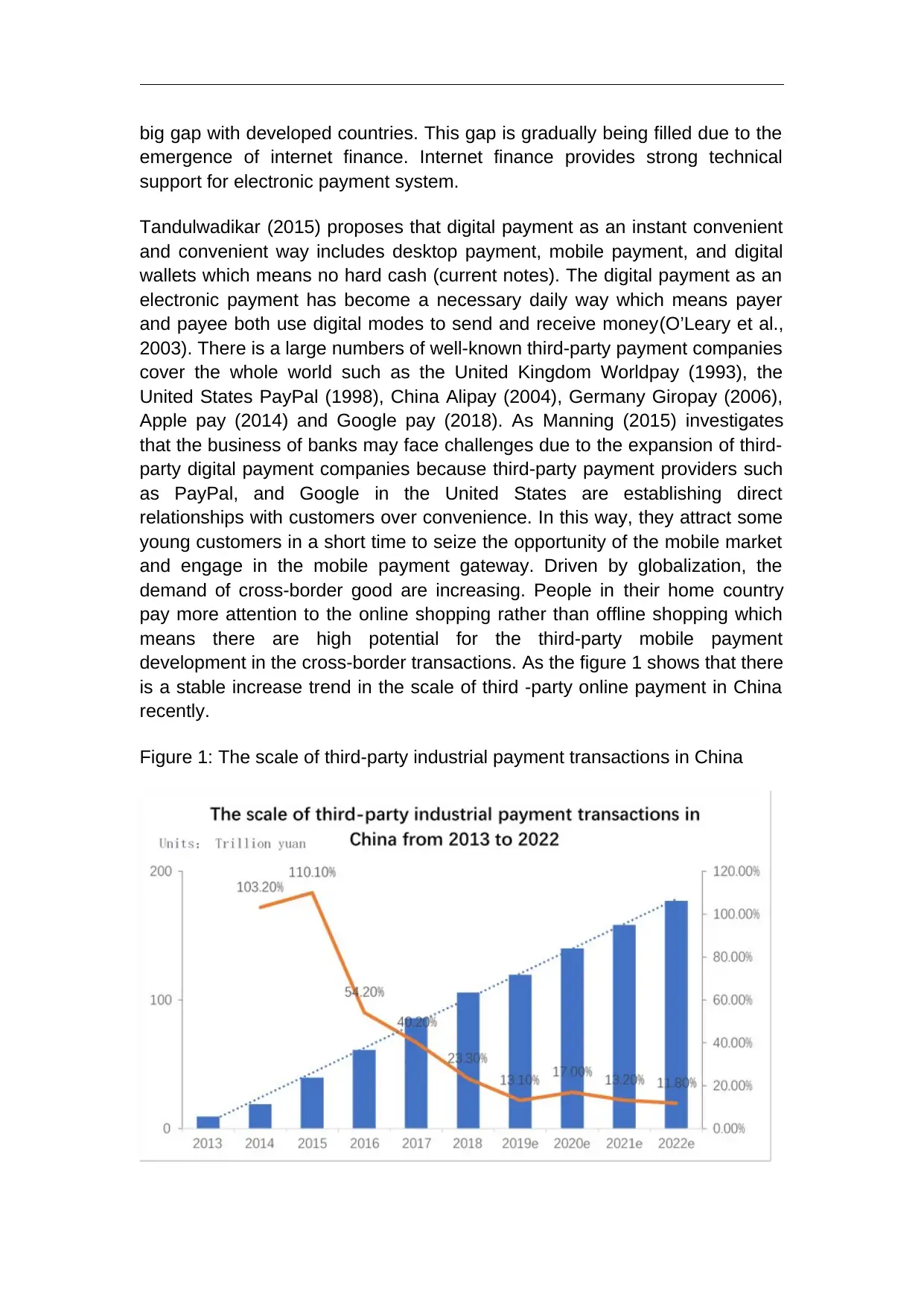
big gap with developed countries. This gap is gradually being filled due to the
emergence of internet finance. Internet finance provides strong technical
support for electronic payment system.
Tandulwadikar (2015) proposes that digital payment as an instant convenient
and convenient way includes desktop payment, mobile payment, and digital
wallets which means no hard cash (current notes). The digital payment as an
electronic payment has become a necessary daily way which means payer
and payee both use digital modes to send and receive money(O’Leary et al.,
2003). There is a large numbers of well-known third-party payment companies
cover the whole world such as the United Kingdom Worldpay (1993), the
United States PayPal (1998), China Alipay (2004), Germany Giropay (2006),
Apple pay (2014) and Google pay (2018). As Manning (2015) investigates
that the business of banks may face challenges due to the expansion of third-
party digital payment companies because third-party payment providers such
as PayPal, and Google in the United States are establishing direct
relationships with customers over convenience. In this way, they attract some
young customers in a short time to seize the opportunity of the mobile market
and engage in the mobile payment gateway. Driven by globalization, the
demand of cross-border good are increasing. People in their home country
pay more attention to the online shopping rather than offline shopping which
means there are high potential for the third-party mobile payment
development in the cross-border transactions. As the figure 1 shows that there
is a stable increase trend in the scale of third -party online payment in China
recently.
Figure 1: The scale of third-party industrial payment transactions in China
emergence of internet finance. Internet finance provides strong technical
support for electronic payment system.
Tandulwadikar (2015) proposes that digital payment as an instant convenient
and convenient way includes desktop payment, mobile payment, and digital
wallets which means no hard cash (current notes). The digital payment as an
electronic payment has become a necessary daily way which means payer
and payee both use digital modes to send and receive money(O’Leary et al.,
2003). There is a large numbers of well-known third-party payment companies
cover the whole world such as the United Kingdom Worldpay (1993), the
United States PayPal (1998), China Alipay (2004), Germany Giropay (2006),
Apple pay (2014) and Google pay (2018). As Manning (2015) investigates
that the business of banks may face challenges due to the expansion of third-
party digital payment companies because third-party payment providers such
as PayPal, and Google in the United States are establishing direct
relationships with customers over convenience. In this way, they attract some
young customers in a short time to seize the opportunity of the mobile market
and engage in the mobile payment gateway. Driven by globalization, the
demand of cross-border good are increasing. People in their home country
pay more attention to the online shopping rather than offline shopping which
means there are high potential for the third-party mobile payment
development in the cross-border transactions. As the figure 1 shows that there
is a stable increase trend in the scale of third -party online payment in China
recently.
Figure 1: The scale of third-party industrial payment transactions in China
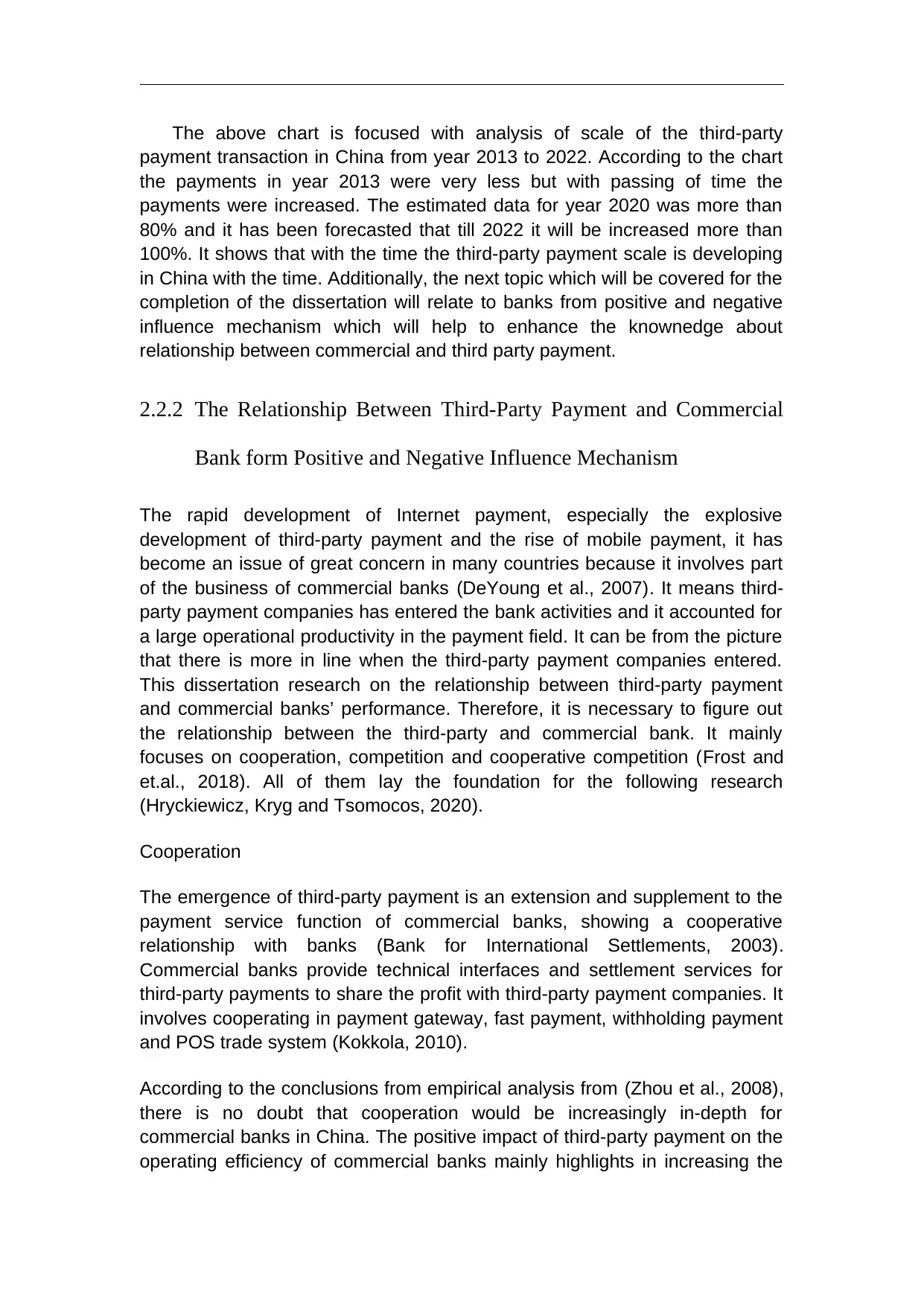
The above chart is focused with analysis of scale of the third-party
payment transaction in China from year 2013 to 2022. According to the chart
the payments in year 2013 were very less but with passing of time the
payments were increased. The estimated data for year 2020 was more than
80% and it has been forecasted that till 2022 it will be increased more than
100%. It shows that with the time the third-party payment scale is developing
in China with the time. Additionally, the next topic which will be covered for the
completion of the dissertation will relate to banks from positive and negative
influence mechanism which will help to enhance the knownedge about
relationship between commercial and third party payment.
2.2.2 The Relationship Between Third-Party Payment and Commercial
Bank form Positive and Negative Influence Mechanism
The rapid development of Internet payment, especially the explosive
development of third-party payment and the rise of mobile payment, it has
become an issue of great concern in many countries because it involves part
of the business of commercial banks (DeYoung et al., 2007). It means third-
party payment companies has entered the bank activities and it accounted for
a large operational productivity in the payment field. It can be from the picture
that there is more in line when the third-party payment companies entered.
This dissertation research on the relationship between third-party payment
and commercial banks’ performance. Therefore, it is necessary to figure out
the relationship between the third-party and commercial bank. It mainly
focuses on cooperation, competition and cooperative competition (Frost and
et.al., 2018). All of them lay the foundation for the following research
(Hryckiewicz, Kryg and Tsomocos, 2020).
Cooperation
The emergence of third-party payment is an extension and supplement to the
payment service function of commercial banks, showing a cooperative
relationship with banks (Bank for International Settlements, 2003).
Commercial banks provide technical interfaces and settlement services for
third-party payments to share the profit with third-party payment companies. It
involves cooperating in payment gateway, fast payment, withholding payment
and POS trade system (Kokkola, 2010).
According to the conclusions from empirical analysis from (Zhou et al., 2008),
there is no doubt that cooperation would be increasingly in-depth for
commercial banks in China. The positive impact of third-party payment on the
operating efficiency of commercial banks mainly highlights in increasing the
payment transaction in China from year 2013 to 2022. According to the chart
the payments in year 2013 were very less but with passing of time the
payments were increased. The estimated data for year 2020 was more than
80% and it has been forecasted that till 2022 it will be increased more than
100%. It shows that with the time the third-party payment scale is developing
in China with the time. Additionally, the next topic which will be covered for the
completion of the dissertation will relate to banks from positive and negative
influence mechanism which will help to enhance the knownedge about
relationship between commercial and third party payment.
2.2.2 The Relationship Between Third-Party Payment and Commercial
Bank form Positive and Negative Influence Mechanism
The rapid development of Internet payment, especially the explosive
development of third-party payment and the rise of mobile payment, it has
become an issue of great concern in many countries because it involves part
of the business of commercial banks (DeYoung et al., 2007). It means third-
party payment companies has entered the bank activities and it accounted for
a large operational productivity in the payment field. It can be from the picture
that there is more in line when the third-party payment companies entered.
This dissertation research on the relationship between third-party payment
and commercial banks’ performance. Therefore, it is necessary to figure out
the relationship between the third-party and commercial bank. It mainly
focuses on cooperation, competition and cooperative competition (Frost and
et.al., 2018). All of them lay the foundation for the following research
(Hryckiewicz, Kryg and Tsomocos, 2020).
Cooperation
The emergence of third-party payment is an extension and supplement to the
payment service function of commercial banks, showing a cooperative
relationship with banks (Bank for International Settlements, 2003).
Commercial banks provide technical interfaces and settlement services for
third-party payments to share the profit with third-party payment companies. It
involves cooperating in payment gateway, fast payment, withholding payment
and POS trade system (Kokkola, 2010).
According to the conclusions from empirical analysis from (Zhou et al., 2008),
there is no doubt that cooperation would be increasingly in-depth for
commercial banks in China. The positive impact of third-party payment on the
operating efficiency of commercial banks mainly highlights in increasing the
⊘ This is a preview!⊘
Do you want full access?
Subscribe today to unlock all pages.

Trusted by 1+ million students worldwide
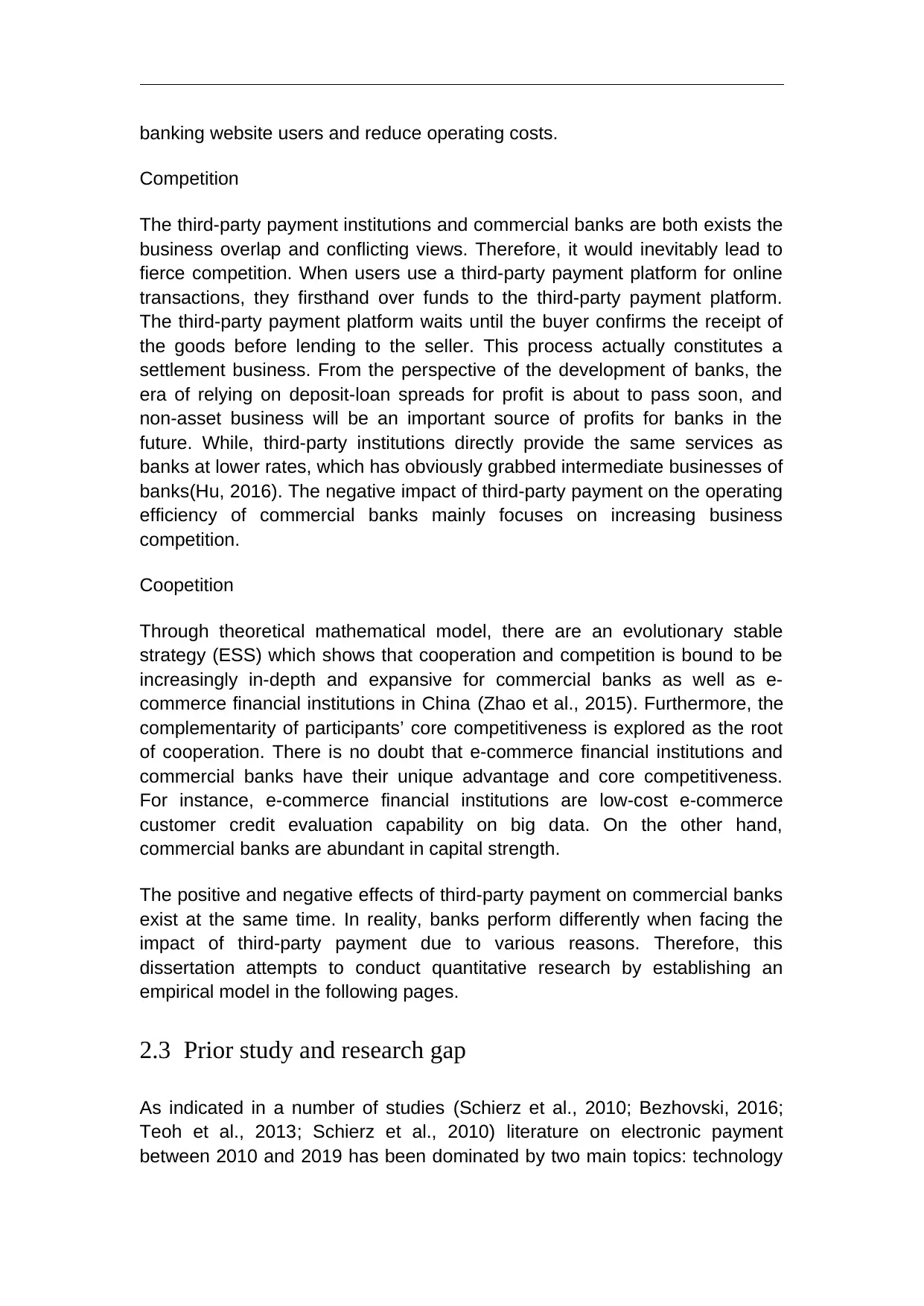
banking website users and reduce operating costs.
Competition
The third-party payment institutions and commercial banks are both exists the
business overlap and conflicting views. Therefore, it would inevitably lead to
fierce competition. When users use a third-party payment platform for online
transactions, they firsthand over funds to the third-party payment platform.
The third-party payment platform waits until the buyer confirms the receipt of
the goods before lending to the seller. This process actually constitutes a
settlement business. From the perspective of the development of banks, the
era of relying on deposit-loan spreads for profit is about to pass soon, and
non-asset business will be an important source of profits for banks in the
future. While, third-party institutions directly provide the same services as
banks at lower rates, which has obviously grabbed intermediate businesses of
banks(Hu, 2016). The negative impact of third-party payment on the operating
efficiency of commercial banks mainly focuses on increasing business
competition.
Coopetition
Through theoretical mathematical model, there are an evolutionary stable
strategy (ESS) which shows that cooperation and competition is bound to be
increasingly in-depth and expansive for commercial banks as well as e-
commerce financial institutions in China (Zhao et al., 2015). Furthermore, the
complementarity of participants’ core competitiveness is explored as the root
of cooperation. There is no doubt that e-commerce financial institutions and
commercial banks have their unique advantage and core competitiveness.
For instance, e-commerce financial institutions are low-cost e-commerce
customer credit evaluation capability on big data. On the other hand,
commercial banks are abundant in capital strength.
The positive and negative effects of third-party payment on commercial banks
exist at the same time. In reality, banks perform differently when facing the
impact of third-party payment due to various reasons. Therefore, this
dissertation attempts to conduct quantitative research by establishing an
empirical model in the following pages.
2.3 Prior study and research gap
As indicated in a number of studies (Schierz et al., 2010; Bezhovski, 2016;
Teoh et al., 2013; Schierz et al., 2010) literature on electronic payment
between 2010 and 2019 has been dominated by two main topics: technology
Competition
The third-party payment institutions and commercial banks are both exists the
business overlap and conflicting views. Therefore, it would inevitably lead to
fierce competition. When users use a third-party payment platform for online
transactions, they firsthand over funds to the third-party payment platform.
The third-party payment platform waits until the buyer confirms the receipt of
the goods before lending to the seller. This process actually constitutes a
settlement business. From the perspective of the development of banks, the
era of relying on deposit-loan spreads for profit is about to pass soon, and
non-asset business will be an important source of profits for banks in the
future. While, third-party institutions directly provide the same services as
banks at lower rates, which has obviously grabbed intermediate businesses of
banks(Hu, 2016). The negative impact of third-party payment on the operating
efficiency of commercial banks mainly focuses on increasing business
competition.
Coopetition
Through theoretical mathematical model, there are an evolutionary stable
strategy (ESS) which shows that cooperation and competition is bound to be
increasingly in-depth and expansive for commercial banks as well as e-
commerce financial institutions in China (Zhao et al., 2015). Furthermore, the
complementarity of participants’ core competitiveness is explored as the root
of cooperation. There is no doubt that e-commerce financial institutions and
commercial banks have their unique advantage and core competitiveness.
For instance, e-commerce financial institutions are low-cost e-commerce
customer credit evaluation capability on big data. On the other hand,
commercial banks are abundant in capital strength.
The positive and negative effects of third-party payment on commercial banks
exist at the same time. In reality, banks perform differently when facing the
impact of third-party payment due to various reasons. Therefore, this
dissertation attempts to conduct quantitative research by establishing an
empirical model in the following pages.
2.3 Prior study and research gap
As indicated in a number of studies (Schierz et al., 2010; Bezhovski, 2016;
Teoh et al., 2013; Schierz et al., 2010) literature on electronic payment
between 2010 and 2019 has been dominated by two main topics: technology
Paraphrase This Document
Need a fresh take? Get an instant paraphrase of this document with our AI Paraphraser
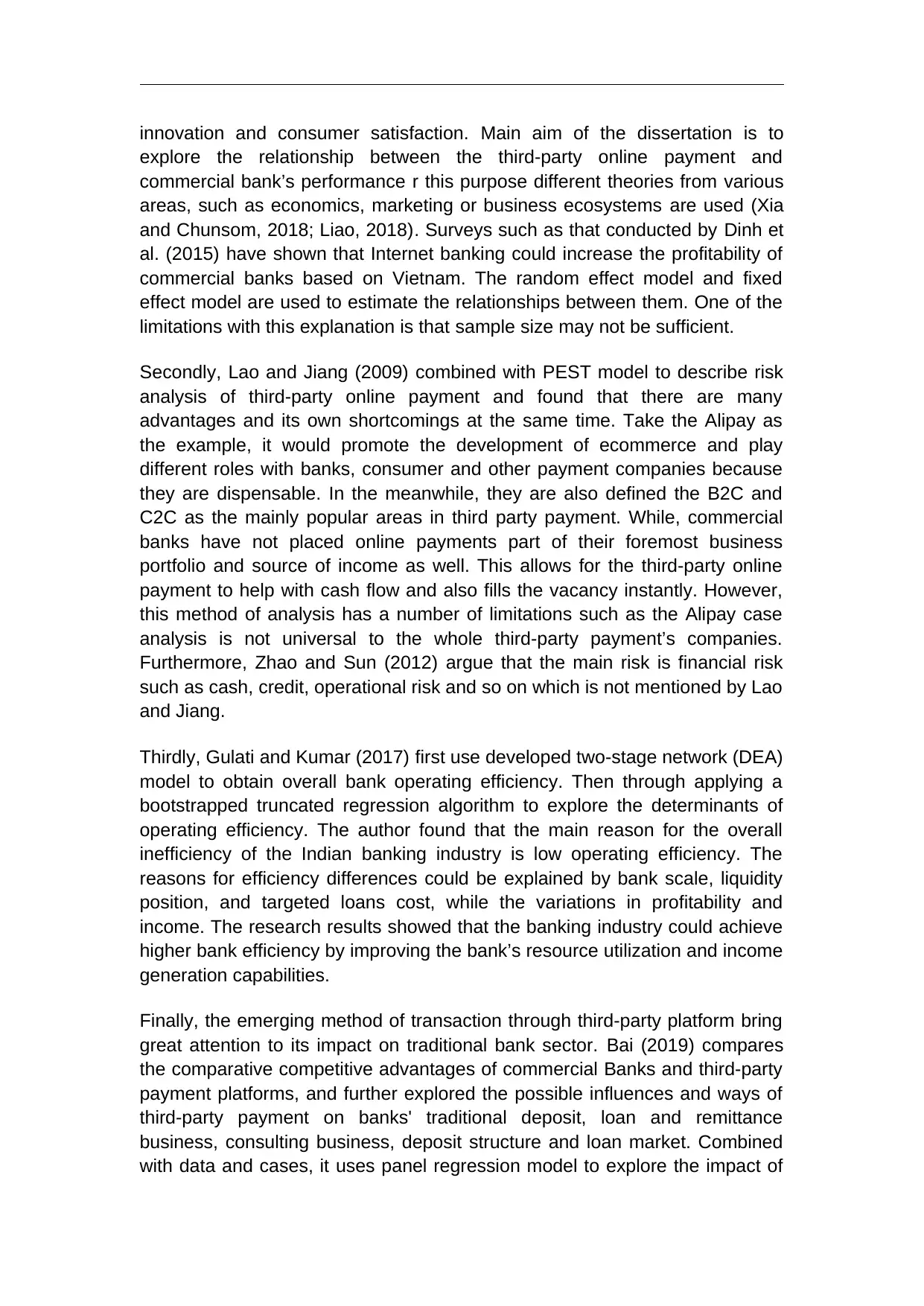
innovation and consumer satisfaction. Main aim of the dissertation is to
explore the relationship between the third-party online payment and
commercial bank’s performance r this purpose different theories from various
areas, such as economics, marketing or business ecosystems are used (Xia
and Chunsom, 2018; Liao, 2018). Surveys such as that conducted by Dinh et
al. (2015) have shown that Internet banking could increase the profitability of
commercial banks based on Vietnam. The random effect model and fixed
effect model are used to estimate the relationships between them. One of the
limitations with this explanation is that sample size may not be sufficient.
Secondly, Lao and Jiang (2009) combined with PEST model to describe risk
analysis of third-party online payment and found that there are many
advantages and its own shortcomings at the same time. Take the Alipay as
the example, it would promote the development of ecommerce and play
different roles with banks, consumer and other payment companies because
they are dispensable. In the meanwhile, they are also defined the B2C and
C2C as the mainly popular areas in third party payment. While, commercial
banks have not placed online payments part of their foremost business
portfolio and source of income as well. This allows for the third-party online
payment to help with cash flow and also fills the vacancy instantly. However,
this method of analysis has a number of limitations such as the Alipay case
analysis is not universal to the whole third-party payment’s companies.
Furthermore, Zhao and Sun (2012) argue that the main risk is financial risk
such as cash, credit, operational risk and so on which is not mentioned by Lao
and Jiang.
Thirdly, Gulati and Kumar (2017) first use developed two-stage network (DEA)
model to obtain overall bank operating efficiency. Then through applying a
bootstrapped truncated regression algorithm to explore the determinants of
operating efficiency. The author found that the main reason for the overall
inefficiency of the Indian banking industry is low operating efficiency. The
reasons for efficiency differences could be explained by bank scale, liquidity
position, and targeted loans cost, while the variations in profitability and
income. The research results showed that the banking industry could achieve
higher bank efficiency by improving the bank’s resource utilization and income
generation capabilities.
Finally, the emerging method of transaction through third-party platform bring
great attention to its impact on traditional bank sector. Bai (2019) compares
the comparative competitive advantages of commercial Banks and third-party
payment platforms, and further explored the possible influences and ways of
third-party payment on banks' traditional deposit, loan and remittance
business, consulting business, deposit structure and loan market. Combined
with data and cases, it uses panel regression model to explore the impact of
explore the relationship between the third-party online payment and
commercial bank’s performance r this purpose different theories from various
areas, such as economics, marketing or business ecosystems are used (Xia
and Chunsom, 2018; Liao, 2018). Surveys such as that conducted by Dinh et
al. (2015) have shown that Internet banking could increase the profitability of
commercial banks based on Vietnam. The random effect model and fixed
effect model are used to estimate the relationships between them. One of the
limitations with this explanation is that sample size may not be sufficient.
Secondly, Lao and Jiang (2009) combined with PEST model to describe risk
analysis of third-party online payment and found that there are many
advantages and its own shortcomings at the same time. Take the Alipay as
the example, it would promote the development of ecommerce and play
different roles with banks, consumer and other payment companies because
they are dispensable. In the meanwhile, they are also defined the B2C and
C2C as the mainly popular areas in third party payment. While, commercial
banks have not placed online payments part of their foremost business
portfolio and source of income as well. This allows for the third-party online
payment to help with cash flow and also fills the vacancy instantly. However,
this method of analysis has a number of limitations such as the Alipay case
analysis is not universal to the whole third-party payment’s companies.
Furthermore, Zhao and Sun (2012) argue that the main risk is financial risk
such as cash, credit, operational risk and so on which is not mentioned by Lao
and Jiang.
Thirdly, Gulati and Kumar (2017) first use developed two-stage network (DEA)
model to obtain overall bank operating efficiency. Then through applying a
bootstrapped truncated regression algorithm to explore the determinants of
operating efficiency. The author found that the main reason for the overall
inefficiency of the Indian banking industry is low operating efficiency. The
reasons for efficiency differences could be explained by bank scale, liquidity
position, and targeted loans cost, while the variations in profitability and
income. The research results showed that the banking industry could achieve
higher bank efficiency by improving the bank’s resource utilization and income
generation capabilities.
Finally, the emerging method of transaction through third-party platform bring
great attention to its impact on traditional bank sector. Bai (2019) compares
the comparative competitive advantages of commercial Banks and third-party
payment platforms, and further explored the possible influences and ways of
third-party payment on banks' traditional deposit, loan and remittance
business, consulting business, deposit structure and loan market. Combined
with data and cases, it uses panel regression model to explore the impact of
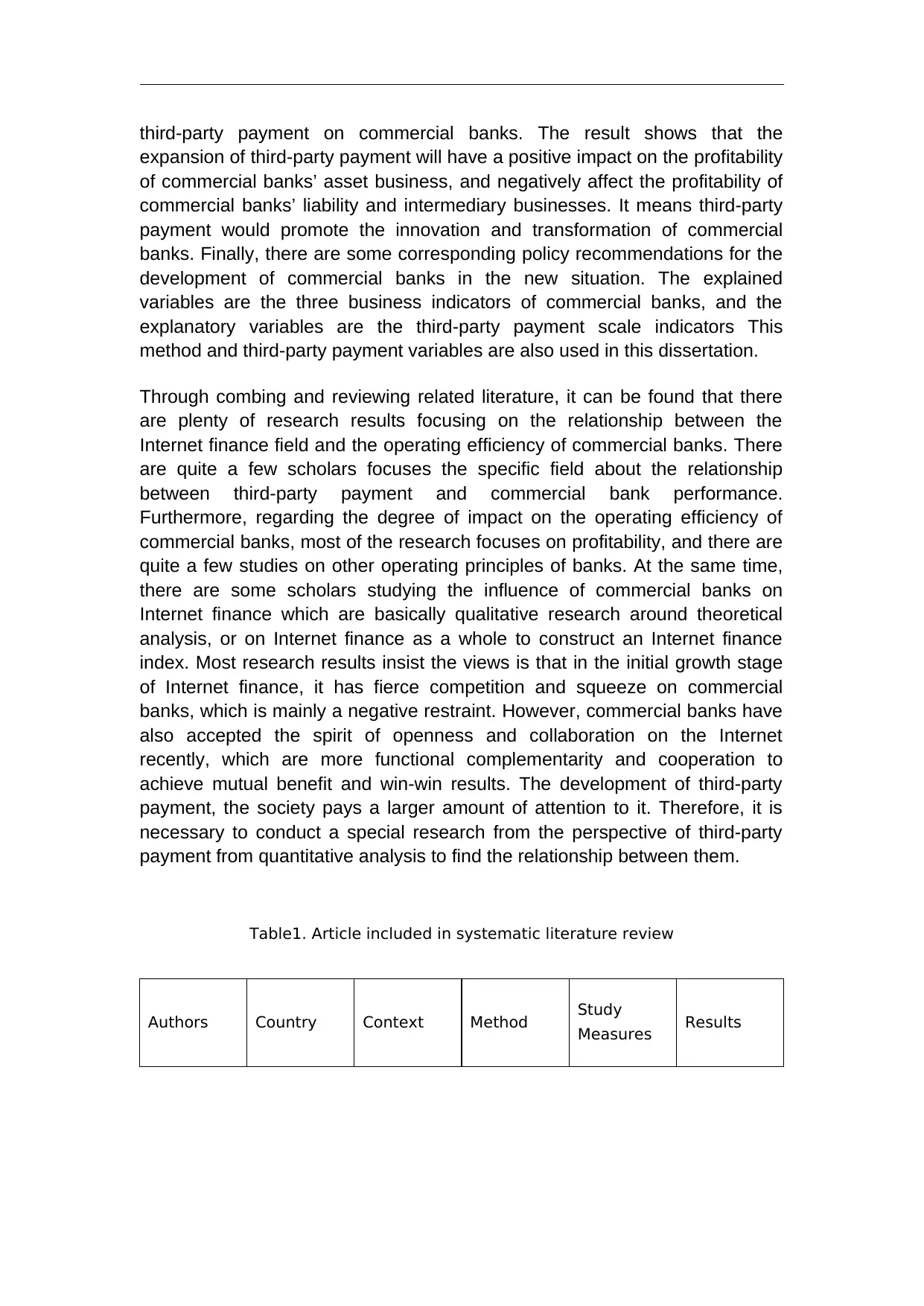
third-party payment on commercial banks. The result shows that the
expansion of third-party payment will have a positive impact on the profitability
of commercial banks’ asset business, and negatively affect the profitability of
commercial banks’ liability and intermediary businesses. It means third-party
payment would promote the innovation and transformation of commercial
banks. Finally, there are some corresponding policy recommendations for the
development of commercial banks in the new situation. The explained
variables are the three business indicators of commercial banks, and the
explanatory variables are the third-party payment scale indicators This
method and third-party payment variables are also used in this dissertation.
Through combing and reviewing related literature, it can be found that there
are plenty of research results focusing on the relationship between the
Internet finance field and the operating efficiency of commercial banks. There
are quite a few scholars focuses the specific field about the relationship
between third-party payment and commercial bank performance.
Furthermore, regarding the degree of impact on the operating efficiency of
commercial banks, most of the research focuses on profitability, and there are
quite a few studies on other operating principles of banks. At the same time,
there are some scholars studying the influence of commercial banks on
Internet finance which are basically qualitative research around theoretical
analysis, or on Internet finance as a whole to construct an Internet finance
index. Most research results insist the views is that in the initial growth stage
of Internet finance, it has fierce competition and squeeze on commercial
banks, which is mainly a negative restraint. However, commercial banks have
also accepted the spirit of openness and collaboration on the Internet
recently, which are more functional complementarity and cooperation to
achieve mutual benefit and win-win results. The development of third-party
payment, the society pays a larger amount of attention to it. Therefore, it is
necessary to conduct a special research from the perspective of third-party
payment from quantitative analysis to find the relationship between them.
Table1. Article included in systematic literature review
Authors Country Context Method Study
Measures Results
expansion of third-party payment will have a positive impact on the profitability
of commercial banks’ asset business, and negatively affect the profitability of
commercial banks’ liability and intermediary businesses. It means third-party
payment would promote the innovation and transformation of commercial
banks. Finally, there are some corresponding policy recommendations for the
development of commercial banks in the new situation. The explained
variables are the three business indicators of commercial banks, and the
explanatory variables are the third-party payment scale indicators This
method and third-party payment variables are also used in this dissertation.
Through combing and reviewing related literature, it can be found that there
are plenty of research results focusing on the relationship between the
Internet finance field and the operating efficiency of commercial banks. There
are quite a few scholars focuses the specific field about the relationship
between third-party payment and commercial bank performance.
Furthermore, regarding the degree of impact on the operating efficiency of
commercial banks, most of the research focuses on profitability, and there are
quite a few studies on other operating principles of banks. At the same time,
there are some scholars studying the influence of commercial banks on
Internet finance which are basically qualitative research around theoretical
analysis, or on Internet finance as a whole to construct an Internet finance
index. Most research results insist the views is that in the initial growth stage
of Internet finance, it has fierce competition and squeeze on commercial
banks, which is mainly a negative restraint. However, commercial banks have
also accepted the spirit of openness and collaboration on the Internet
recently, which are more functional complementarity and cooperation to
achieve mutual benefit and win-win results. The development of third-party
payment, the society pays a larger amount of attention to it. Therefore, it is
necessary to conduct a special research from the perspective of third-party
payment from quantitative analysis to find the relationship between them.
Table1. Article included in systematic literature review
Authors Country Context Method Study
Measures Results
⊘ This is a preview!⊘
Do you want full access?
Subscribe today to unlock all pages.

Trusted by 1+ million students worldwide
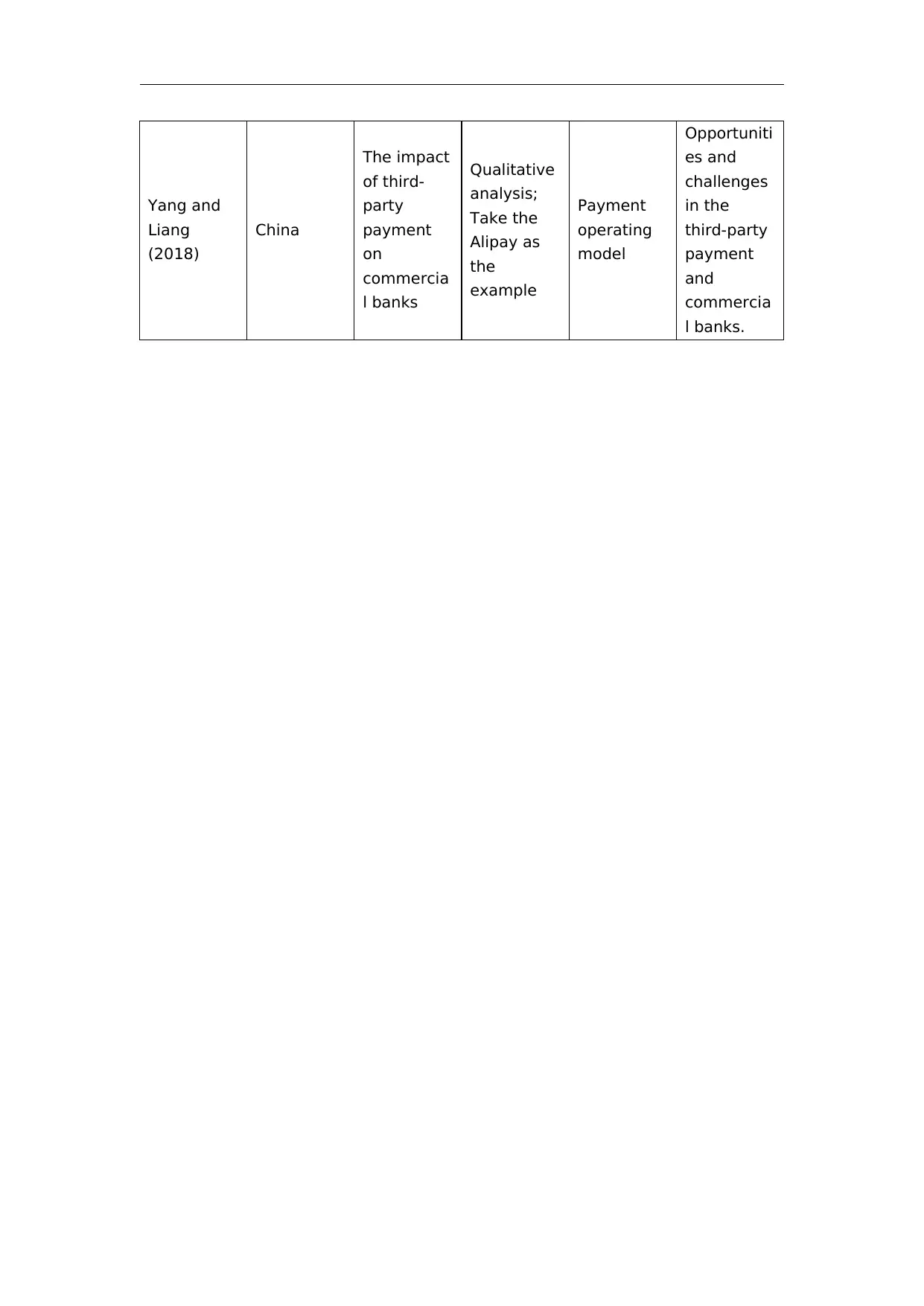
Yang and
Liang
(2018)
China
The impact
of third-
party
payment
on
commercia
l banks
Qualitative
analysis;
Take the
Alipay as
the
example
Payment
operating
model
Opportuniti
es and
challenges
in the
third-party
payment
and
commercia
l banks.
Liang
(2018)
China
The impact
of third-
party
payment
on
commercia
l banks
Qualitative
analysis;
Take the
Alipay as
the
example
Payment
operating
model
Opportuniti
es and
challenges
in the
third-party
payment
and
commercia
l banks.
Paraphrase This Document
Need a fresh take? Get an instant paraphrase of this document with our AI Paraphraser
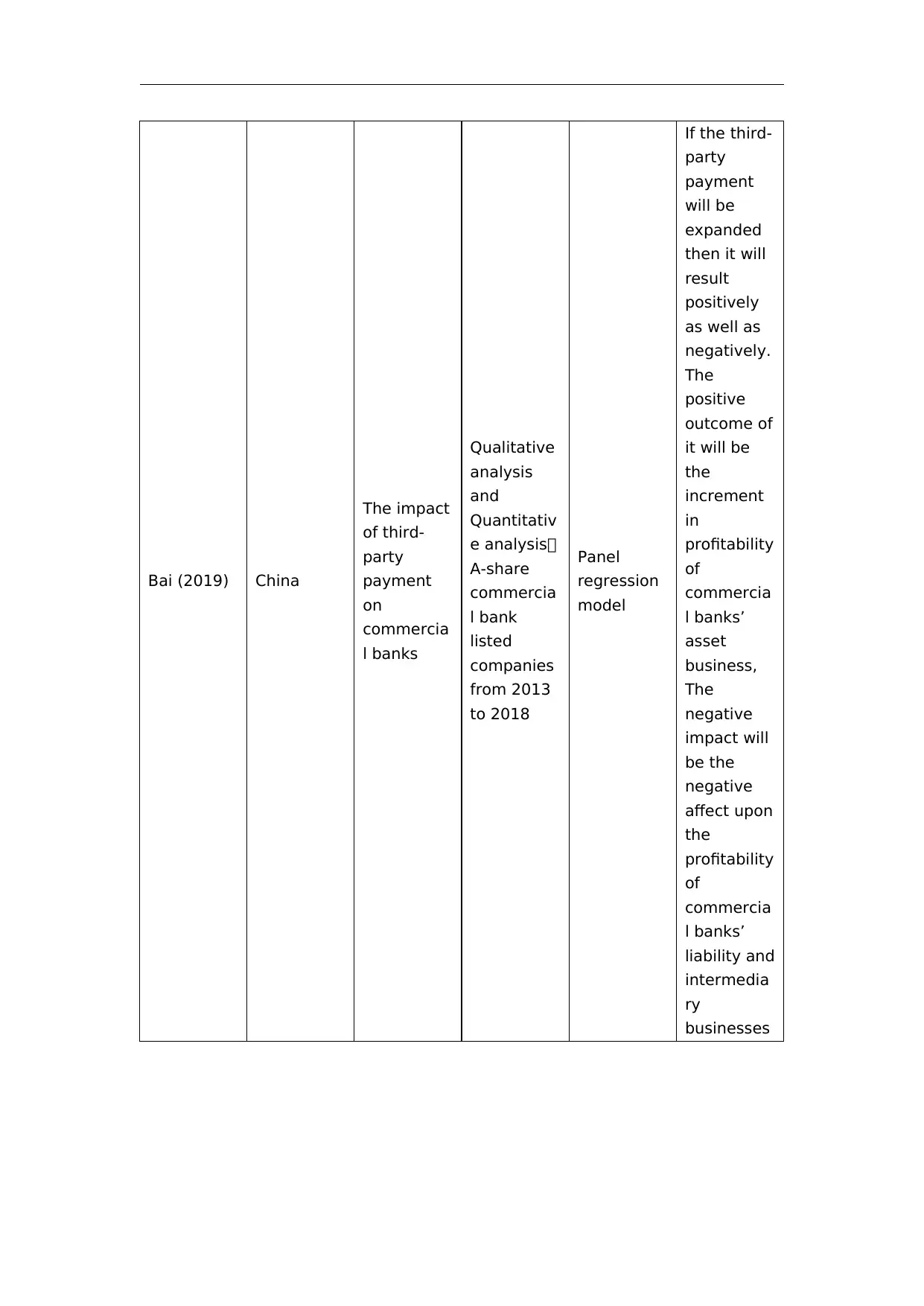
Bai (2019) China
The impact
of third-
party
payment
on
commercia
l banks
Qualitative
analysis
and
Quantitativ
e analysis;
A-share
commercia
l bank
listed
companies
from 2013
to 2018
Panel
regression
model
If the third-
party
payment
will be
expanded
then it will
result
positively
as well as
negatively.
The
positive
outcome of
it will be
the
increment
in
profitability
of
commercia
l banks’
asset
business,
The
negative
impact will
be the
negative
affect upon
the
profitability
of
commercia
l banks’
liability and
intermedia
ry
businesses
The impact
of third-
party
payment
on
commercia
l banks
Qualitative
analysis
and
Quantitativ
e analysis;
A-share
commercia
l bank
listed
companies
from 2013
to 2018
Panel
regression
model
If the third-
party
payment
will be
expanded
then it will
result
positively
as well as
negatively.
The
positive
outcome of
it will be
the
increment
in
profitability
of
commercia
l banks’
asset
business,
The
negative
impact will
be the
negative
affect upon
the
profitability
of
commercia
l banks’
liability and
intermedia
ry
businesses
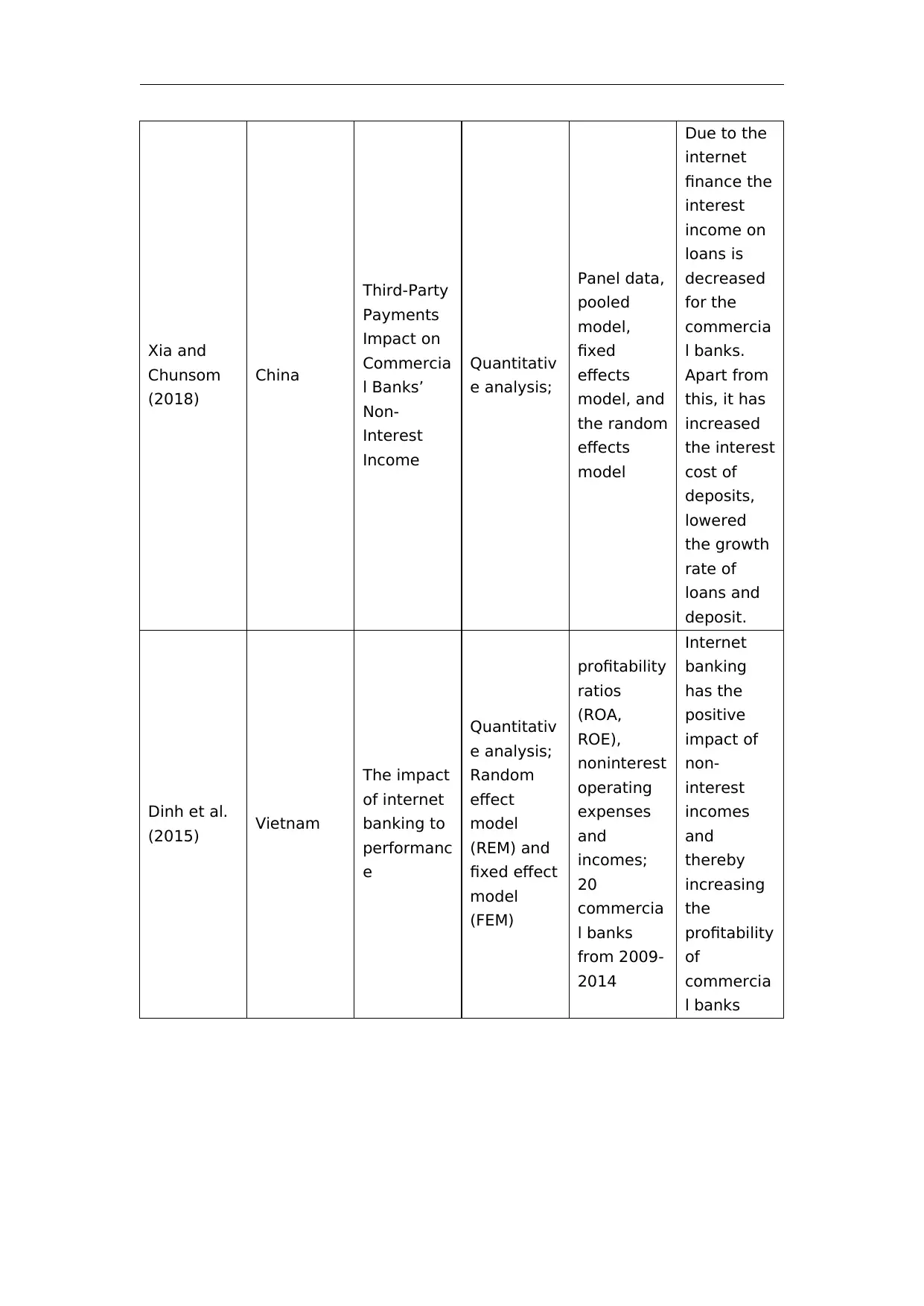
Xia and
Chunsom
(2018)
China
Third-Party
Payments
Impact on
Commercia
l Banks’
Non-
Interest
Income
Quantitativ
e analysis;
Panel data,
pooled
model,
fixed
effects
model, and
the random
effects
model
Due to the
internet
finance the
interest
income on
loans is
decreased
for the
commercia
l banks.
Apart from
this, it has
increased
the interest
cost of
deposits,
lowered
the growth
rate of
loans and
deposit.
Dinh et al.
(2015) Vietnam
The impact
of internet
banking to
performanc
e
Quantitativ
e analysis;
Random
effect
model
(REM) and
fixed effect
model
(FEM)
profitability
ratios
(ROA,
ROE),
noninterest
operating
expenses
and
incomes;
20
commercia
l banks
from 2009-
2014
Internet
banking
has the
positive
impact of
non-
interest
incomes
and
thereby
increasing
the
profitability
of
commercia
l banks
Chunsom
(2018)
China
Third-Party
Payments
Impact on
Commercia
l Banks’
Non-
Interest
Income
Quantitativ
e analysis;
Panel data,
pooled
model,
fixed
effects
model, and
the random
effects
model
Due to the
internet
finance the
interest
income on
loans is
decreased
for the
commercia
l banks.
Apart from
this, it has
increased
the interest
cost of
deposits,
lowered
the growth
rate of
loans and
deposit.
Dinh et al.
(2015) Vietnam
The impact
of internet
banking to
performanc
e
Quantitativ
e analysis;
Random
effect
model
(REM) and
fixed effect
model
(FEM)
profitability
ratios
(ROA,
ROE),
noninterest
operating
expenses
and
incomes;
20
commercia
l banks
from 2009-
2014
Internet
banking
has the
positive
impact of
non-
interest
incomes
and
thereby
increasing
the
profitability
of
commercia
l banks
⊘ This is a preview!⊘
Do you want full access?
Subscribe today to unlock all pages.

Trusted by 1+ million students worldwide
1 out of 28
Related Documents
Your All-in-One AI-Powered Toolkit for Academic Success.
+13062052269
info@desklib.com
Available 24*7 on WhatsApp / Email
![[object Object]](/_next/static/media/star-bottom.7253800d.svg)
Unlock your academic potential
Copyright © 2020–2025 A2Z Services. All Rights Reserved. Developed and managed by ZUCOL.





